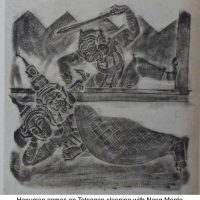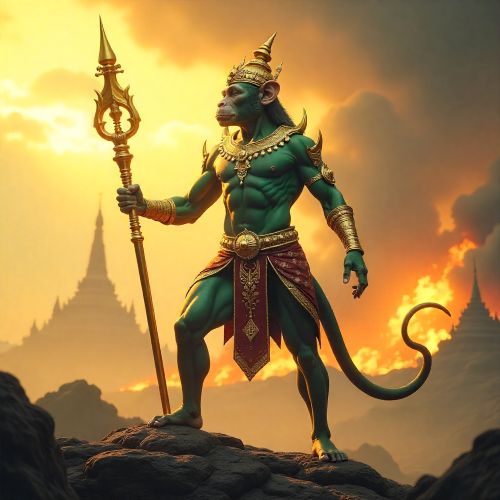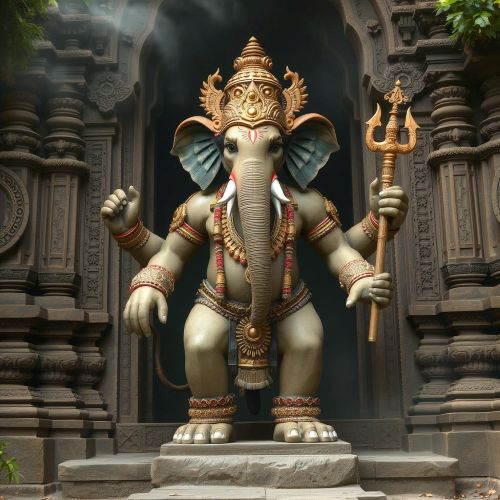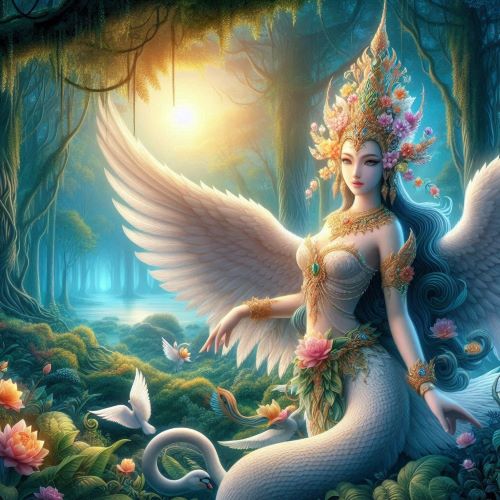Nang Monto : The Graceful Queen of Longka
Listen
At a glance
| Description | |
|---|---|
| Origin | Thai Mythology |
| Classification | Hybrids |
| Family Members | Thotsakan (Husband) |
| Region | Thailand |
| Associated With | Royalty. Intelligencel |
Nang Monto
Introduction
Nang Monto is one of the most captivating female figures in Thai mythology, featured prominently in The Ramakien, the Thai adaptation of the Indian Ramayana. Within this epic, she is known as the consort of Thotsakan—the mighty demon king of Longka—and, in some versions, as the companion of Phali, the powerful monkey king. Her story interlaces the divine, demonic, and human realms, showcasing her as both a victim of fate and a symbol of grace and devotion.
Much like Mandodari in the Indian Ramayana, Nang Monto embodies intelligence, compassion, and quiet resilience. Her tale not only reflects the grandeur of Thai mythic literature but also mirrors the country’s deep-rooted cultural fusion of Hindu and Buddhist traditions. Over time, Nang Monto has transcended her epic origins to become an enduring emblem of loyalty, beauty, and emotional strength in Thai art and storytelling.
Physical Traits
In Thai art and traditional performances, Nang Monto is portrayed as the epitome of celestial beauty. She is often shown with a fair, radiant complexion, almond-shaped eyes, and a serene expression that exudes both dignity and tenderness. Her attire reflects her royal status, adorned with intricate golden jewelry, ornate crowns, and flowing silk garments in deep red or emerald hues—colors symbolizing devotion and divine power.
Her visual depiction is intentionally distinct from that of her husband, Thotsakan, who is usually portrayed with green skin and an imposing, fearsome appearance. This contrast reinforces her purity and moral virtue amid the chaos of war and vengeance surrounding her. In temple murals and Khon dance dramas, her gestures are slow and deliberate, capturing her inner strength and grace, which contrast sharply with the fiery nature of those around her.
Family
Nang Monto’s family connections are key to her role in The Ramakien. As the queen of Longka, she is married to Thotsakan, the ten-headed demon king. However, her story takes a complex turn when she is later taken by Phali, the heroic monkey king and rival to Thotsakan. From her union with Phali is born Ongkot (known as Angada in the Ramayana), who becomes a valiant warrior and loyal follower of Phra Ram (Rama).
These relationships make Nang Monto a pivotal link between the divine, demonic, and simian worlds of Thai mythology. Despite being associated with Thotsakan—the central antagonist—she remains a morally upright and emotionally nuanced character. Her maternal affection for Ongkot also elevates her beyond her role as a queen, portraying her as a nurturing figure torn between love and duty.
Other names
While “Nang Monto” is her common Thai name, her story traces back to “Mandodari,” the queen of Ravana in the original Ramayana. The adaptation of her name across Southeast Asia reflects the cultural diffusion of Indian epics throughout the region. In Cambodia, she appears in the Reamker as “Mondea,” and in Laos, she is occasionally referred to by similar variants.
Within Thailand, variations such as “Montho” or “Monto” often appear in literature and classical performances, reflecting transliteration differences. Each adaptation retains her essence as a paragon of virtue, embodying the ideal of a loyal and intelligent queen caught in the turmoil of destiny.
Powers and Abilities
Nang Monto’s powers are subtle yet profound. Unlike divine warriors or sorcerers, her strength lies in her wisdom, emotional intelligence, and spiritual depth. Legends describe her as skilled in sacred rituals and knowledgeable in magical arts—abilities that she uses to protect her family and kingdom rather than for destruction.
One notable tale speaks of a mystical bond that tied her fate to Phali through a divine enchantment, which could only be broken under specific conditions. This motif reflects her dual nature—both subject to cosmic forces and yet capable of altering destiny through her moral strength.
In some interpretations, Nang Monto is also believed to possess prophetic insight, understanding the greater balance of karma that governs the universe. Her quiet power, expressed through faith, compassion, and endurance, becomes a moral counterweight to the destructive ambitions of her husband.
Modern Day Influence
The legacy of Nang Monto continues to shape Thai culture today. Her story remains a staple of Khon (classical masked dance-drama), where her role demands a balance of elegance and emotional restraint. The Khon Montho performance, in particular, highlights her sorrow and devotion during key scenes from The Ramakien.
Murals and sculptures depicting Nang Monto can be found in sacred sites such as Wat Phra Kaew (The Temple of the Emerald Buddha), where her image stands as a reminder of virtue amid chaos. In contemporary Thai media, her character appears in animated films, television adaptations, and literary retellings that reinterpret her as a symbol of womanly strength and emotional resilience.
Beyond Thailand, her story resonates throughout Southeast Asia, connecting shared mythological roots across the region. Her legacy extends to educational curricula and cultural festivals, where she represents the timeless ideals of loyalty, inner strength, and compassion.
Related Images
Source
Ramakien. (2004). In Wikipedia. https://en.wikipedia.org/wiki/Ramakien
R is for the Ramakien (Epics from A to Z). (2015). Multicolored Diary. http://multicoloreddiary.blogspot.com/2015/04/r-is-for-ramakien-epics-from-to-z.html
Dhaninivat, K. (1969). The Ramakien: The Thai Epic. Bangkok: The Fine Arts Department.
Sweeney, A. (1994). The Ramayana and the Malay World. University of California Press.
Brandon, J.R. (1967). Theatre in Southeast Asia. Harvard University Press.
Supaporn Vathanaprida. (1994). Folk Tales of Thailand. Libraries Unlimited.
Wyatt, D. K. (2003). Thailand: A Short History (2nd ed.). Yale University Press.
Chitakasem, Y. (1995). Thai Literary Traditions and Cultural Identity. Bangkok: Chulalongkorn University Press.
Rajadhon, P. A. (1961). Essays on Thai Folklore. Bangkok: Thai Culture Committee.
Terwiel, B. J. (2011). Monks and Magic: An Analysis of Religious Ceremonies in Central Thailand. Silkworm Books.
Thai Ramakien Archive. (n.d.). Royal Consorts of Totsakan. Retrieved from https://ramakien.org/characters/totsakan-consorts
Wikipedia. (n.d.). Nang Monto. Retrieved from https://en.wikipedia.org/wiki/Nang_Monto
Srisakra, V. (1980). Women in Thai Epic Literature. Journal of Southeast Asian Studies, 11(2), 234–245.
Gods and Monsters. (n.d.). Thai Mythological Queens and Consorts. Retrieved from https://godsandmonsters.info/thai-mythology-queens/
Frequently Asked Questions
Who is Nang Monto in Thai mythology?
Nang Monto is the queen of Thotsakan in the Ramakien, the Thai version of the Ramayana. She represents beauty, virtue, and loyalty amid the conflicts of gods and demons.
Is Nang Monto the same as Mandodari from the Indian Ramayana?
Yes. Nang Monto is the Thai adaptation of Mandodari, Ravana’s queen, though her story is localized with unique cultural details and symbolic interpretations.
What is Nang Monto’s connection to Phali and Ongkot?
How is Nang Monto represented in Thai art and performance?
She is prominently featured in Khon masked dance dramas and temple murals, portrayed as a figure of elegance and emotional strength adorned in golden royal attire.
What does Nang Monto symbolize in Thai culture today?
Nang Monto symbolizes compassion, endurance, and moral integrity. Her story serves as a timeless reminder of love’s resilience and the virtues of loyalty and sacrifice.










